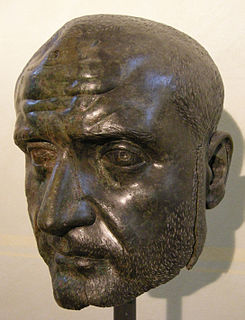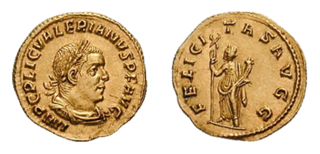
Claudius Gothicus, also known as Claudius II, was Roman emperor from 268 to 270. During his reign he fought successfully against the Alemanni and decisively defeated the Goths at the Battle of Naissus. He died after succumbing to "pestilence", possibly the Plague of Cyprian that had ravaged the provinces of the Empire.

Trebonianus Gallus, also known as Gallus, was Roman Emperor from June 251 to August 253, in a joint rule with his son Volusianus.

Marcus Cassianius Latinius Postumus was a Roman commander of Batavian origin who ruled as Emperor in the West. The Roman army in Gaul threw off its allegiance to Gallienus around the year 260, and Postumus assumed the title and powers of Emperor in the provinces of Gaul, Germania, Britannia and Hispania, thereby founding what scholars have dubbed the Gallic Empire. He ruled for the better part of ten years before he was murdered by his own troops.

Legio trigesima Ulpia victrix was a legion of the Imperial Roman army. It was founded in AD 100 by the emperor Trajan for service in the Dacian Wars. The legion was active until disbandment of the Rhine frontier in the beginning of the 5th century. Their emblems were the gods Neptune and Jupiter and the Capricorn. Ulpia is Trajan's own gens (Ulpia), while the cognomen "Victrix" means "victorious", and was awarded after their valiant behaviour in the Dacian wars.

A legatus was a high-ranking Roman military officer in the Roman Army, equivalent to a modern high-ranking general officer. Initially used to delegate power, the term became formalised under Augustus as the officer in command of a legion.

Titus Fulvius Junius Quietus was a Roman usurper against Roman Emperor Gallienus.

Manius Acilius Aureolus was a Roman military commander and would-be usurper. He was one of the so-called Thirty Tyrants who populated the reign of the Emperor Gallienus. Of humble Daco-Roman origins, he was 'made' by the Emperor Gallienus and proved himself to be one of the most brilliant and innovative soldiers of the age. However, he later turned against his benefactor, and was destroyed in the political turmoil that surrounded the Emperor's assassination in a conspiracy orchestrated by his senior officers. The ancient sources which refer to Aureolus are limited and the information they do provide is often contradictory. They include the Historia Augusta, Zonaras' epitome and Zosimus' Historia Nova. His career was most recently summarised in John Bray's biography of Gallienus. The analysis of Aureolus's career given here, especially his final rebellion, is largely based on Bray.

Publius Licinius Cornelius Valerianus, also known as Valerian II, was the eldest son of Roman Emperor Gallienus and Augusta Cornelia Salonina who was of Greek origin and grandson of the Emperor Valerian who was of a noble and traditional senatorial family.

Publius Licinius Cornelius Saloninus Valerianus was Roman Emperor in 260.
Marcus(?) Aurelius Heraclianus was a Roman soldier who rose to the rank of Praetorian Prefect in the latter part of the reign of the Emperor Gallienus. He was a member of the cabal of senior commanders of the Imperial field army that plotted and achieved the assassination of the Emperor Gallienus. His subsequent fate is uncertain. The only ancient reference has him committing suicide, but the circumstances are unclear.
Volusianus was a Roman citizen, apparently of equestrian origins, whose career in the Imperial Service in the mid-Third Century AD carried him from a relatively modest station in life to the highest public offices and senatorial status in a very few years. He may have secured his first appointments before the Licinian Dynasty - - acceded to the Empire in 253 AD, but it was in the course of their reign that his upward progress achieved an almost unprecedented momentum and the second factor seems to have been a consequence of the first. The nature of his relationship to the Licinii is uncertain, but it seems likely that a common origin in the Etruscan region of central Italy at least predisposed Gallienus in his favour and he seems to have been that emperor's most trusted servant and adviser during the period of his sole reign - 260(?)-268 AD.
Aurelius/Iulius Marcellinus was a Roman soldier and Imperial functionary who had a brilliant equestrian career and was elevated to the Senate when he was chosen by the Emperor Aurelian as his consular colleague. His appointment as Consul is thought to have been a reward for his loyalty and steadfastness in 273 when, as Aurelian's deputy in charge of the eastern provinces of the Empire where the authority of the Imperial Government had only recently been restored, he resisted attempts to suborn him by a rebellious faction in the city of Palmyra.
Traianus Mucianus was a Roman soldier of Thracian origins of the second half of the Third Century AD who rose from the lowest ranks of the army to senior commands. He was almost certainly a remarkable soldier. However, the successive promotions he secured in the latter part of his career are thought to owe much also to the favour shown him by men highly placed in the Imperial entourage whose patronage secured him advantageous postings in the Imperial comitatus, the mobile field force under the direct command of the Emperor, that was undergoing massive expansion at this time.
Lucius Aurelius Marcianus was a Roman soldier whose military career coincided with the period of crisis that characterized the middle decades of the Third Century AD – see Crisis of the Third Century. Probably of humble origins in one of the Illyrician provinces of the Empire he was one of the group of men from this region who chose a military career – or had it chosen for them – whose professional capabilities brought them to the fore of public life in those troubled times. Marcianus rose to the highest levels of the military hierarchy. The evidence suggests that he earned the trust of the Emperors Gallienus and Claudius II and, possibly, Marcus Aurelius Probus among their successors and that he was one of the principal commanders in the prolonged war against a coalition of what the late antique Greek writers called Scythian peoples whose incursions in that period seemed to threaten the very survival of the Roman state. These would refer to the major Germanic and Iranian peoples, among them the Goths and Roxolani, who invaded the Roman empire across the lower Danube River.












